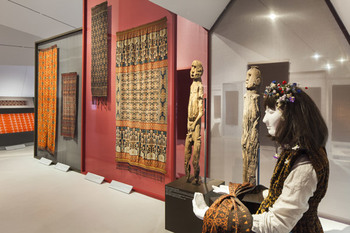Du 1er Octobre 2016 au 26 Mars 2017
 Museum der Kulturen Basel
Museum der Kulturen Basel
Münsterplatz 20
4051 Basel
Suisse
L’exposition présente de fascinants ikats provenant de l’Indonésie de l’est et du Timor Leste. Depuis des temps immémoriaux les femmes maîtresses tisserandes de ces pays ont adopté des motifs étrangers et les ont intégrés dans leurs conceptions locales propres de manière intrigante.
L’exposition est complétée par des interprétations contemporaines de Ito Joyoatmojo et Susi Kramer qui ses sont inspirés des ikats de l’ile de Flores dans leur propres créations.
Le Musée des cultures de Bale fait partie des musées ethnographiques les plus importants d’Europe. Sa collection relative aux formes et phénomènes de modes de vie humains est impressionnante. Outre les deux expositions permanentes, trois à cinq expositions temporaires sont présentées chaque année. Le musée incite à se pencher sur ” l’Autre ” – source d’inspiration pour de nouvelles manières de voir, d’évaluer et de se positionner par rapport au ” Soi “.
The designs of these textiles include, among others, surprising motifs such as Indian flowers, European roses, angels, airplanes and elephants. Some of the cloths have a soft golden hue, others shine in bright synthetic colors. One can interpret these features as early traces of globalization, with some of them reaching back as far as the sixteenth century. The varied display includes a wide range of high-quality ikat cloths created by master weavers. Ever since ikat began, weavers have incorporated foreign influences and thus have actively been engaged in the process of globalization. It began as long ago as the ninth century with maritime trade and the export of textiles from India to the Indonesian archipelago. Trade in the area reached a climax in the sixteenth century under the impact of Portuguese and Dutch mercantile expeditions. This also explains why many of the cloths on display feature designs such as the Indian eight-pointed flower pattern, Portuguese cross-stitch patterns as well as various Catholic motifs. Since the 1970s the tourist industry has increasingly impacted on the art of ikat weaving. A telling example of this influence is the motif showing tourist couples taking selfies at colorful volcanic lakes. “These master weavers incorporate their own understanding of modernity and fashion trends. They strive for individuality but at the same time they accommodate to the taste of their customers”, says Richard Kunz. Tradition is regarded as a facet of modernity. Kunz and de Jong’s research trip last year showed that the art of ikat in eastern Indonesia and East Timor is very much alive and highly dynamic. In many local communities ikat cloths still play a key role in social life. They are worn on festive occasions and provide important markers of prestige, one of the reasons why weavers are esteemed as accomplished artists. The exhibition includes portraits of six weavers in which they speak of their life and their work, enabling viewers a more personal access to the cloths on display.
